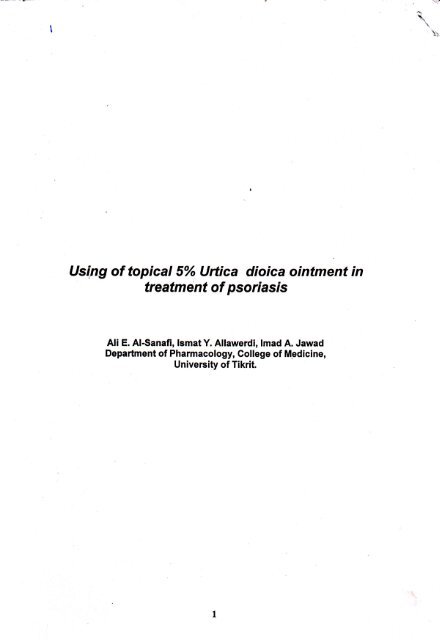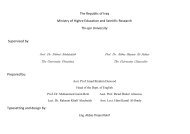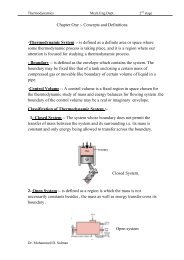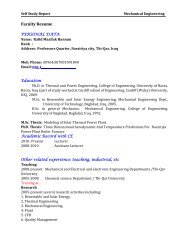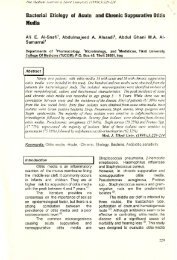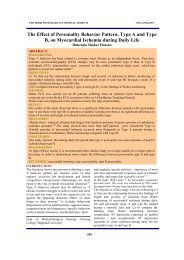Using Of Topical 5% Udica Dioica Ointment In
Using Of Topical 5% Udica Dioica Ointment In
Using Of Topical 5% Udica Dioica Ointment In
You also want an ePaper? Increase the reach of your titles
YUMPU automatically turns print PDFs into web optimized ePapers that Google loves.
t<br />
<strong>Using</strong> of topical <strong>5%</strong> <strong>Udica</strong> dioica ointm ent in<br />
treatm ènt of psoriasis<br />
AIi E. Al-sanafi, Ism at Y. Allawerdi, Im ad A. Jawad<br />
Department of Pharmaqology, College of Mpdicine,<br />
University of Tikrit.<br />
1
d.<br />
<strong>Using</strong> of topical <strong>5%</strong> U/fca dioica ointm ent in<br />
treatm ent of psoriasis<br />
Abstract : .<br />
Tropical urtica dioica <strong>5%</strong> ointment was applied twice daily for 3 months<br />
by 53 qatients with psoriasis. Patients were classified to 6 groups according to<br />
extenslon of psoriatic lesions. The efficacy of the treatment was determ ined<br />
folowing a 4 grades criteria, cleared, marked im provem ent , moderate<br />
im provem ent, and m inim al or no im provement . <strong>In</strong> 3: out of 53 patients<br />
(71.6980/4, aI psoriatic Iesions were cleared. ln 9 patients (16.981%) there<br />
was marked improvement, and in 6 patients (11.320%) there was no<br />
im provement. '<br />
The best results were obtained in Iocalized Ie'ss extensive Iesions . The<br />
electiveness of Urtica dioica treatment could be attributed to its vitam in A and<br />
flavonoids contents. lt is a cheap, safe and effective remedy for this chronic<br />
disabiling skin disorder.<br />
o r w.i .p + I r 1 z.xl t-ax * -e w /'z > V j * I oj f *, . ,.G # ( Q/o j 5 ar t . ) kyxw- .x A p' a ( Q/: ! 4 u 5 A 1 )<br />
c* a x-ai e * q . .-. !1 c. M œ- Q/: o K- ye 1 8 .* V . O o. $ . J .t'G '.% ! a* - . .1 ./ .xo,- 1 z h x - 1 olfs 1<br />
1 *, , w I a f . x . .'<br />
e . u ! ' e k. ye j p .p o. j . ko j u. . ' j ., J >. % . A, o %. ' j p j .ywe N : we<br />
* u* + % , .- ! j >' y c . > z. : % c* euj<br />
j à a<br />
<strong>In</strong>troduction :<br />
' Psoriasis is a chronic skin disorder characterized by we l dem arcated<br />
thickened ey hematous area of skin covered by silver scales. The disease is<br />
highly variable (1' in its extent and duration . Morphological variants are<br />
Com m on Patients with a fam ily history tend to have an earlier onset of the<br />
.<br />
diseasetz) M any factors play a definite role in the developm ent of the disease #<br />
,<br />
.<br />
those include traum a, stress, infection, drugs , clim ate, metabolic factors,<br />
tSmO king , and alcohol consumptiono-o . Treatment ofysoriasis may be solely<br />
öpical or it may be system ic, or a combination of botht )<br />
A wide range of drugs were used in treatment of this disease . These<br />
include, calcipotrial, vitam in A, corticosteroids , anthralin, cyclosporine A,<br />
met h o trexate, and psoralen with Iong-wave ultra violet light (PUVA)t'6-12) . <strong>In</strong> a<br />
previous histological experim ental study, when m ouse tail skin was used as a<br />
model mimikinj human psoriasis, it was appeared that 40 days treatment with<br />
<strong>5%</strong> <strong>Udica</strong> diolca ointm ent was effective in psoriasis based on epiderm al<br />
thickness and keratinocyte number . The safety of this concentration was also<br />
prov idetl3) , The present prospective contro led study is carried out to evaluate<br />
the e fectiveness of topical <strong>5%</strong> Ulica dioica ointm ent in patient volunteers<br />
with Iocalized psoriasis.<br />
2
Patients and Methods :<br />
The study w as carried out on 53 patients (32 males and 21 females),<br />
1 1-63 years in age, atending many private dermatology outpatient clinics in<br />
Kirkuk and Qaghdad. Urtica dioica L. (Urticaceae) ointment was prepared by<br />
mixing 5 gr. of the powder of the Ieaves of the herb with 95 gr . of vaseline<br />
vehicle. The ointm ent was topicaly applied to the affected skin , twice daily for<br />
6 m onths. 10 patients were topica ly treated with the vehicle vaseline by the<br />
same m anner and for the sam e period. Patients were classified into 5 groups<br />
according to the extension of the lesion according to the (rule of nine) stated<br />
b Y Diette : and M orimoto and Yashikowatl4'ls) '<br />
1St group ' The surface area of the lesion >4<strong>5%</strong> of the body .<br />
2nG group : The surface area of the Iesion 36-44% of . the body.<br />
3rd tb group : The surface area of the Iesion 26-3<strong>5%</strong> of the body.<br />
4 group The surface area of the Iesion 21-2<strong>5%</strong> of the body .<br />
5th th group . The surface area of the Iesion 15 -20% of the body.<br />
6 group : The su#ace area of the Iesion *1<strong>5%</strong> of the body ,<br />
The e'icacy of the topical <strong>Udica</strong> dioica treatment was determined<br />
folowing the 4 grades criteria of W einsteintl6)<br />
1- Cleared ' If aIl lesions were disappeared .<br />
2- M arked im provem ent If 50-94% of the Iesions were cleared .<br />
3-'M oderate im provement : lf 10-49% of the lesions were cleared .<br />
4- Minimal or no improvement : If Iess than 10% of the Iesions were<br />
cleared, or if they stated the same .<br />
Results :<br />
The study showed that Urtica dioica <strong>5%</strong> ointm ent cleared a I psoriatic<br />
lesions in 38 out of 53 patients (71.698%). Marked improvement was<br />
recorded in '9 patients (16.981%), while minimal improvement was recorded in<br />
6 patients (1 1.320%). The Iast six patients showed alergy to the treatment ,<br />
and the treatment was stopped after two weeks treatment (Table 1, Fig. 1-3).<br />
The high percentage of e fectiveness was recorded in Iocalized non extensive<br />
Iesions.<br />
However, in the majority of the patients, the treatment cause mild<br />
itching in the first three days of the initiation of the treatm ent . This itching can<br />
easily tolerated and didn't need cessation of the treatment .<br />
3
$<br />
Table 1 : response of patients w ith psoriasis after G ice daily treatment<br />
w ith <strong>5%</strong> Uiica dioica ointm ent for 3 m onths.<br />
Treated groups<br />
Total Response<br />
e: of psoriatic surface area I body surface Qrade<br />
45<br />
3$<br />
7 1 .693Q4<br />
8 6 6 6 3 4 Cleared (alI Ieslons<br />
were cleared)<br />
9<br />
16 .9810/0<br />
3 2 2 1 11 1 Marked Improvement<br />
tsc-g4v.of were cleared) the Ieslons<br />
Mlnlmal or no<br />
6 - 1 1 4 Improvement l (less than<br />
cx of the Ieslons were<br />
1 .320% cleared orthey stated<br />
the same<br />
4
A B<br />
Fig. 1 -A: Psoriatic Iesions involving chest abdom en and u<br />
B : Resolution of the Iesions after ! qper Iimbs.<br />
G lce daily applicatlon of <strong>Udica</strong><br />
diok a ointm ent for 3 m onths .<br />
5
4<br />
A B<br />
Fig. 2-A : P/oriàtic Iesion involving chest an'd abdom'éEn .<br />
B : R esolution of the lesions after tw ice dailv applidation<br />
of Urtica dioica ointm ent for 3 months.<br />
6
A<br />
Fig.3-A.W idely extended psoriasis<br />
B'.Resolution of the Ietions after twice daily applications of Urtica dioica<br />
<strong>5%</strong> ointm ent for 1 m onth .<br />
7
Discusion :<br />
The concentration of Ulica dioica and preparation of the ointm ent used<br />
in this study was previously recom m ended based on the efficacy and safety in<br />
im ental anim alstlo Urljca dioica herb contains m any pharm acologica ly<br />
exper .<br />
active compounds, these include flavonoids (quercetin , rutin and kaempferol),<br />
vitam in A and C , enzymes, Iecithin, amines, carbonic acids (formic and citric<br />
ac ids) and minerals especialy calcium and potassium saIts(1&20) The<br />
.<br />
effectiveness of <strong>Udica</strong> dioica topical treatm ent could be attributed to its<br />
vitam in A content. Vitam in A is involved in m aintaining differentiation of skin<br />
cels. The retinoid is photosensitive com pound , and there are a specific<br />
transport protein (Retinol-binding protein) which has its own receptors in<br />
human epiderm is in stratum corneum and stratum granulosum tzl) Ja ret and<br />
Spearman (22) stated<br />
that the effectiveness of vitam in A in inducing a granular<br />
Iayer in the psoriatic skin was atributed to its rectifying efect on the ruptured<br />
Iysosomes.<br />
On the other hand, various flavonoids were found to be relatively<br />
selective inhibitors of arachidonate s-lipoxygenase which initiates the<br />
biosynthesis of Ieukotrienpstz3'z4) It was known that s-lipoxygenase products<br />
such as lz-hydroxy eicosotetraenoic acid and Ieucotriene B4 are several folds<br />
e Ievated in psoriatic epiderm is as com pared to uninvolved skint25'26) These<br />
Ieucotriepes cause persistent erythem atous reaction that is associated . with<br />
enhancéd epidermopoesis , leukocyte infiltration in derm is , and the<br />
appearance o f microabscesses in the epiderm istzs) al1 these<br />
,<br />
pathophysiological event mimiking the feature of psoriasis . Thus the<br />
effectiveness of Ulica dioica ointm ent in psoriasis could be attributed to its<br />
flavonoids l content which are potent inhibitors of arachidonate s-lipoxygenase. n conclusion J Qrtica dioica <strong>5%</strong> ointment was recom m ended in<br />
treatm ent of psoriasls. The best results were expected w hen the lesion is<br />
localized. The treatm ent is cheap , safe, and e fective.<br />
8
#<br />
References :<br />
1- Cam p., RDR. Psoriasis. ln : Rook , W ilkinson and Ebting. Textbook of<br />
derm atology, 6 th e d k, voI . 2 , Edited by Cham pion RH., Burton, JL., Burns,<br />
,<br />
DA. And Breathnach, SM . Blackwel Science Ltd. 1998 : pp 1589-1649.<br />
2- Melski JW ., and Stern RS. The separation of susceptibility of psoriasis<br />
from age of onset., J. <strong>In</strong>vest. Derm atol , 1981,. 77 : 474-477.<br />
3- Henseler T. The genetics of psoriasis. J. Am . Acad. Derm atol. 1977., 37 :<br />
S1-S11.<br />
4- Gonalez S., Diaz F., Rius F., and Vargas 1 . Study of cedain clinical<br />
variables in patients with psoriasis and their relation to DNA content<br />
keratinoc/es. J, Am. Acad. Dermatol. 1995., 22 . 218-222.<br />
5- Baker BS., Bokth S,, Powiks A ., Garioch JJt, Lewis H., and Valdimarsson<br />
H . Group A streptococcal antigen specific T-lym phocyte in gutate psoriatic<br />
Iesion. Br. J. Derm atol. 1993; 128 : 493-499 .<br />
6 Arnold HL., Odorn RB., and Jam es W D . Disease of the skin. 8th ed . W .B.<br />
Saunders Co. 1990 ; 1-12 198-212 .<br />
7- Kragbale K., Fogh K., and Sogaard H . Long term e#icacy and tolerability<br />
of topical calcipotriol in psoriasis , results of open study. Acta. Derm .<br />
Venereol. 1991 ; 71 475-478.<br />
8- Culen SI. Long term effectiveness and safety to topical calcipotriene for<br />
psoriasis. South Med. J. 1996., 89 1053-1056 .<br />
9- Langer A. A Iong-term multicenter assessment of the safety and tolerability<br />
of calcipotriol ointm ent in the treatment of chronic plaque psoriasis . Br. J.<br />
Derm atol. 1996., 135 385-389.<br />
10- Cunliffe W J. and Bedh-lones J. Com parative study of calcipotriol<br />
ointm ent and betam ethasone l7-valerate ointm ent in patients with<br />
psoriasis vulgaris, J. Am . Acad. Derm atol. 1992* 26 : 736-743.<br />
,<br />
1 1 - Honeyman JF , Sanchez L., and Valdes P . Low dose calosporine<br />
A .im proves sever disabiling psoriasis in Latin America . Latin American<br />
m ulticenter study. <strong>In</strong>t. J. Dermatol . 1995., 34 583-588.<br />
12- Ashton RE., Andre P., Lowe NJ ., and W hitefield M .Anthralin ' historical<br />
and current perspectives. J. Am . Acad. Dermatol . 1983., 9 : 173-192.<br />
13- Al-sam arrae AJ. The e#ect of Urtica dioica herb on the m ouse tail skin<br />
as a model m im iking hum an psoriasis : a histological study . Ph.D. thesis,<br />
Colege of M edicine Tikrit University , 1999.<br />
14- Die te T Psora lne and UV-A and UV-B twice weekly for the treatment<br />
of psoriasis, Arch. Derm atol. 1984,' 120 116-123.<br />
15- Morim oto S., and Yashikawa K . Psoriasis and vitam in Da. Arch.<br />
Dermatol. 1989*, 125 . 227-230 .<br />
16- W einstein E. Methotrexate therapy . Arch. Dermatol. 1989*, 125 277-<br />
280.<br />
17- Monk T. Anthralin-corticosteroid com bination therapy in the treatm ent<br />
of chronic plaque psoriasis . Arch. Derm atol. 1988., 124 : 548-450.<br />
18- British herbal pharm acopeia . British herbal m edical association,<br />
London 1996 : p 224.<br />
19- Mabey R., Mslntyre M ., M ichael P., Duff G ., and Stevens J . The new<br />
age herbalist. How to use herbs for healing , nutrition, body care and<br />
relaxation. A fireside book . Sim on and Schuster INC . New York 1988 : pp<br />
121,124.<br />
9
20- W att JM. and Gerdian MB. The medicinal and poisonous plant of<br />
S outhern<br />
and Eastern Africa. 2nd ed . E. and S. Livingstone Ltd. London<br />
1962 : p 1042-1045.<br />
21- G oldsm ith LA. Biochem istry and physiology of the skin. Oxford<br />
University Press. New York 1978 : p 352-360.<br />
22- Jorett A. and Spearman RIC. Histochem istry of the skin psoriasis. The<br />
English University Press. London 1961 : p 34-52.<br />
23- Yoshim ato T., M asayuki F., and Yam amoto S. Flavonoids : potent<br />
inhibitors of arachidonate s-lipoxygenase. Biochem . Biophys. Res. Com m .<br />
1983., 1 16 : 612-618.<br />
24- Havsteen B. Flavonoids, a class of natural products of high<br />
pharmacological potency. Biochem. Pharmacol. 1983., 32 : 1 141-1 148.<br />
25- Brain, et aI. Psoriasis and Ieucotriene B. Lancet 1982., 2 : 262-263.<br />
26- Grabbe et aI. Identification of chemotactic Iipoxygenase products of<br />
arachidonate m etabolism in psoriatic skin.J.<strong>In</strong>vest.Derm atoI.,1984,82:477-<br />
479.<br />
10


